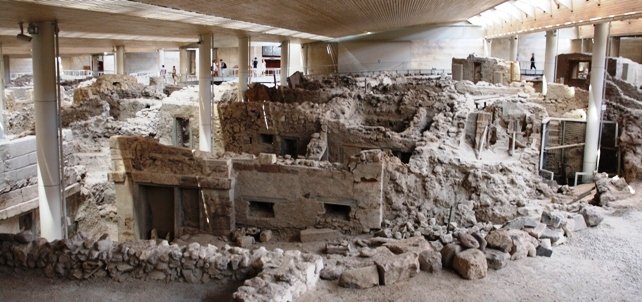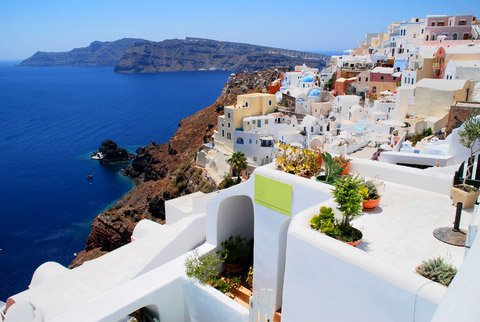There’s nowhere quite like Santorini. Whatever your expectations might be, and however many photos you may see of the island before your visit, you’ll still be amazed. To travel to this island is something everyone ought to do at some stage of their lives.
The surreal volcanic landscape – especially if you approach the island by sea – never fails to impress. The only downside is that because it’s such a fantastic place, you won’t be alone! The best way to get to know the island is to stay there. Santorini is renowned for its sunsets, and the evenings can be relatively calm after all the cruise ships have departed.

A brief history
But this website is about ancient Greece. And Santorini has plenty of ancient history.
The earliest inhabitants were the Carians who lived there in the 3rd millennium BC. Achaeans (early Greeks) are thought to have arrived sometime before 1800BC. From then until the 17th C BC the island prospered. Some think it was closely connected with the Minoan civilisation on Crete, although with its own separate identity.
Akrotiri was the main town from where trade took place. The people of Santorini traded with many of the nations surrounding the Mediterranean. Their products have been found as far afield as Libya. But all this came to an end in about 1600 BC. Although the inhabitants were unaware of it, their island was in fact a huge volcano, and one day it literally blew up. The centre of the island vanished, and some say it was the source of the legend of Atlantis as recorded by Plato.
Billed as Greece’s Pompeii you can experience the excavation of this site in comfort and safety under a new roof. The site was closed since 2005 and re-opened early in 2012. We were awed by the sophistication of this bronze age city that was buried in ash with effectively no warning to its inhabitants.

“One can walk down a street as it was since a short section of the walkway runs between several buildings. Otherwise, one must look at the buildings from the walkway running around the perimeter of the site. Apparently only 3% of the settlement has been excavated. I would recommend taking a guided tour as the guides do give some information and point out details that would otherwise pass unobserved. The guides also point out where the famous frescoes came from which are the real stars of Akrotiri and can only be seen in the Museum of Pre-History at Thera or in the National Archaeological Museum of Athens.” Photo and quote by Mark Cartwright
Santorini was resettled in about 900 BC, but never regained its earlier importance. It had some success as a trading centre during the time of the Egyptian Ptolemies (the dynasty who ruled Egypt after the death of Alexander the Great).


The Caldera
Many visitors who arrive at Santorini by sea don’t
realise what they’re sailing into – much like the
ancient inhabitants!
The sea now fills the caldera, the cone at the top of
the volcano. It’s hard to appreciate the size. The
cliffs you see in the photo above are just the top
rim of the volcano crater.
When you think that this crater is what was left
from a huge eruption, it can’t fail to impress.
What to see

In addition to Akrotiri and the tours you can undertake (visits to the islands in the caldera, exploring the towns, wine tasting tours, etc) there are a number of ancient sites and museums.
One of the best ways to see the sites of Santorini is with an organized tour. Your tour guide will see to all the details – all you have to do is turn up and enjoy it! See Visit-Cyclades for details.
Ancient Thera
You can find the ruins of the ancient capital, Thera, in the south east of the island. From the rocky ridge perched at the top of steep sided cliffs you can see most of the island, and the modern resorts of Kamari and Parissa on the coast.
The city was founded in about 1000BC, and was inhabited until the 13th C. The remains you see of the site are mostly the outlines of the Hellenistic period, although there are also Roman and Byzantine remains as well.
The Archaeological Museum
Some of the most important frescoes discovered at Akrotiri are now in the Athens Archaeological Museum. But you can still see some really good finds in the Archaeological Museum near the cable-car station. This museum contains items found at Akrotiri and ancient Thera, as well as Hellenistic and Roman remains.
Museum of Prehistoric Thera
You’ll find this museum near the bus station. It’s one of my favourites, and contains many treasures from Akrotiri. The best one is a gold statue of an ibex, and is reckoned to date from the 17th C BC.
Petros M Nomilos Conference Centre
Although this is a conference centre, it contains a remarkable exhibition of Wall Painting of Thera. These are life-size reproductions of some of the wall paintings found at Akrotiri. The centre is operated by the Thera Foundation. There are also photos showing the original excavations.
How to get there
This island has enough to occupy you for many days, especially if you like walking, boat trips, wine tasting, sun bathing and swimming (there are a number of beaches on the island, although most are rocky and the ‘sand’ is volcanic ash), and eating out in the evenings.
You can also take day trips to Santorini from other neighbouring islands, including Crete, to which there is also a daily ferry. Flights go direct to Santorini from the UK, usually from Gatwick and some regional airports. Also there are flights to and from Athens.
Learn more about non-ancient Santorini and nearby islands on this personalised travel guide: www.ParosParadise.com
Getting around the island
There is a good bus service, but they tend to get quite crowded in the high season. And at peak times you’re lucky if you can get on at all!
You can hire cars and scooters, but be careful if you do, as the roads are very narrow in places. Taxis are also available, but are best if you can fill them and share the cost.